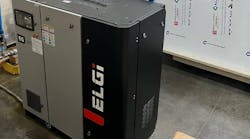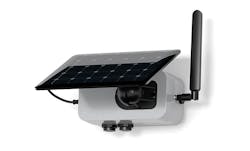In honor of Earth Day (April 22), energy optimization company Lightapp Technologies is giving away 100 air quality monitoring devices (one per plant), along with their software to help manufacturers operate more responsibly and sustainably by tracking air quality. You can go to their site for more on that, but the message, it seems, may be more valuable than the monitor: A plant can decrease emissions and make more money doing it.
Customers of the Israeli company include Pepsi, Coca-Cola, Nestle, Boeing, and Nikon, who all sought the solution to measure and track air quality parameters, using the data to make more responsible decisions and provide a safer work environment for factory workers.
We caught up with Lightapp’s CEO Elhay Farkash to discuss the tech and sustainability in manufacturing overall.
NED: Can you tell us why Lightapp was started? What’s your personal connection?
Elhay Farkash: My co-founder, COO Guy Peer, and I had a lot of exposure to industrial clients working at Oracle, and we came to realize that these clients have a vast amount of data but struggle to collect, analyze and make productive decisions with this data. Growing up in Tel Aviv, my father worked in manufacturing, so from an early age I had an understanding of the challenges manufacturers face both running their operations efficiently and promoting positive environmental outcomes. Starting Lightapp has helped me come full circle by enabling manufacturers to optimize their operations in order to create more profitable and sustainable outcomes.
NED: How does the tech work and who does it benefit most?
EF: After an initial mapping process, which shows customers what data they currently have and what they will need to measure, Lightapp gathers data from existing or newly installed sensors on the plant floor and sends this real-time data to our software, providing insights into consumption, energy efficiency, operational efficiency and machine performance. This data is incredibly useful for engineers and maintenance managers at the plant level to discover and prioritize maintenance activities and for plant managers, purchasing managers and even CFO’s to justify capital expenditure and track KPI’s across multiple facilities.
NED: You did a manufacturing energy cost assessment with California Energy Commission in 2016. What did these E2e study findings tell you about how manufacturers use energy and have you helped turn any of those insights into results?
EF: E2e study has been incredibly interesting as it has shown us that manufacturers often treat high energy spending as a fixed cost, but I think that’s finally beginning to change. As a result, we’ve found huge savings potential across all industries.
I can’t say too much about the official results—those will be released soon—but we’re very excited with the energy reductions and savings we’ve seen. What I can say is that a great deal of positive change we see comes not from the analytics and insights provided by Lightapp themselves, but the communication and engagement Lightapp facilitates. Manufacturers who have recognized the need to reduce energy costs have struggled to galvanize support for these initiatives without the proper tools to share, communicate, and efficiently act.
NED: What’s the biggest myth about factory emissions/pollution?
EF: The biggest myth surrounding emissions is that decreasing emissions and improving operational efficiency are mutually exclusive. In fact, many manufacturers believe that decreasing emissions necessitates some kind of decline in productivity or operational efficiency. We’ve seen that it’s actually possible to increase operational efficiency and throughput through energy management and emissions reductions.
NED: What one thing about energy conservation/waste do you wish every manufacturing executive team knew?
EF: We now live in a world where eliminating energy waste is more profitable than creating it.
NED: What’s up with the 100 monitors you are giving away? How do people get them and when installed, what is their purpose?
EF: We’ve partnered with a company called Clarity that has developed a truly remarkable device to analyze air quality with the same accuracy as a traditional air quality monitoring station at about 1/1000th of the price.
We’re giving them away through our website and shipping them to manufacturers because they take less than five minutes to set up and once they’re set up, they give manufacturers highly accurate information about the air quality at their facility. This data gives can help plants keep track of their emissions and ensure safe working environments for their employees.
Oftentimes, an event at a plant may cause an increase in emissions that the plant itself may not be aware of until a regulator comes by to slap them with a fine. These sensors allow manufacturers to respond in real-time to changes in air quality, allowing them to stay ahead of fines and negative environmental impact. Apart from providing insights about emissions and the working environment of a facility, air quality data can be combined with performance data for machines to schedule predictive maintenance activities, one of our core product offerings.
NED: What’s the best turnaround story you’ve seen from a customer?
EF: We work with a few Bimbo Bakeries facilities, and at one in particular, we were able to save over $150,000 through changes to their compressed air system alone. Initial analysis of the data showed two large 200 hp compressors always running in their plant, but with each fighting for control. When one was loaded the other would unload. Based on this, adjustments were made and one of the large compressors was shut down with a smaller 100 hp taking its place. Lightapp’s data also revealed that multiple machine operators using compressed air to clean out bread pans, was causing large spikes of air usage throughout the day, forcing an additional compressor to turn on and stay on. Not only have they rescheduled blowing to be done over a longer period of time, they have also decided to install a control system. Finally, Bimbo has also begun using blowers instead of compressors for certain operational needs greatly reducing their compressed air demand.











